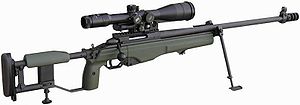
Monopod
Encyclopedia


Camera
A camera is a device that records and stores images. These images may be still photographs or moving images such as videos or movies. The term camera comes from the camera obscura , an early mechanism for projecting images...
s, video camera
Video camera
A video camera is a camera used for electronic motion picture acquisition, initially developed by the television industry but now common in other applications as well. The earliest video cameras were those of John Logie Baird, based on the electromechanical Nipkow disk and used by the BBC in...
s, binoculars
Binoculars
Binoculars, field glasses or binocular telescopes are a pair of identical or mirror-symmetrical telescopes mounted side-by-side and aligned to point accurately in the same direction, allowing the viewer to use both eyes when viewing distant objects...
, rifle
Rifle
A rifle is a firearm designed to be fired from the shoulder, with a barrel that has a helical groove or pattern of grooves cut into the barrel walls. The raised areas of the rifling are called "lands," which make contact with the projectile , imparting spin around an axis corresponding to the...
s or other precision instruments in the field.
Camera and imaging use
The monopod allows a still cameraStill camera
A still camera is a type of camera used to take photographs. Traditional cameras capture light onto photographic film. Digital cameras use electronics, usually a charge coupled device to store digital images in computer memory inside the camera...
to be held steadier, allowing the photographer to take sharp pictures at slower shutter speed
Shutter speed
In photography, shutter speed is a common term used to discuss exposure time, the effective length of time a camera's shutter is open....
s, and/or with longer focal length
Focal length
The focal length of an optical system is a measure of how strongly the system converges or diverges light. For an optical system in air, it is the distance over which initially collimated rays are brought to a focus...
lenses
Photographic lens
A camera lens is an optical lens or assembly of lenses used in conjunction with a camera body and mechanism to make images of objects either on photographic film or on other media capable of storing an image chemically or electronically.While in principle a simple convex lens will suffice, in...
. In the case of video, it reduces camera shake and therefore most of the resulting small random movements. When used by itself, it eliminates camera shake in the vertical plane. When used in combination with leaning against a large object, a bipod is formed; this can also eliminate horizontal motion.
Unlike a tripod
Tripod (photography)
In photography, a tripod is used to stabilize and elevate a camera, or to support flashes or other photographic equipment. All photographic tripods have three legs and a mounting head to couple with a camera...
, monopods cannot support a camera independently. In the case of still cameras, this limits the shutter speed that can be used. They still allow lower shutter speeds than hand holding, and are easier to carry and use than a tripod.
Many monopods can also be used as a "chestpod," or "beltpod," meaning that the foot of the monopod (sometimes with a special adapter) can rest on the belt, waist, or chest, of the photographer. The result is that the camera is held more steadily than by hand alone (though not as steadily as when the foot is planted on the ground), and the camera/monopod is completely mobile, travelling with the photographer's movements. This is similar to a finnstick
Finnstick
A finnstick is the name given by birdwatchers to a stick used to support a binoculars. The one end of the stick is steadily attached to the binocular while the other end rests against the belly....
.
Monopods are usually made to fold or "telescope" quickly when not in use, allowing them to be transported and stored more easily.
Generally, in terms of mobility versus stability, if mobility increases, stability decreases as follows:
- Tripod or tablepod resting on a solid surface (most stable)
- Monopod on solid surface
- Chestpod
- Hand-held (least stable)
Monopods are often equipped with a ball swivel, allowing some freedom to pan and tilt the camera while the monopod remains relatively stationary.
Walking sticks or "trekking poles" exist that have a 1/4"-20 threaded stud on the top of the handle, usually covered by a cap when not in use, allowing them to double as a camera monopod. The user would usually need to carry a ball swivel adapter separately and mount it as needed.
Firearms

Precision optical and measuring instruments
When used to support a compass or transitBrunton compass
A Brunton compass, properly known as the Brunton Pocket Transit, is a type of precision compass made by Brunton, Inc. of Riverton, Wyoming. The instrument was patented in 1894 by a Canadian-born Colorado geologist named David W. Brunton. Unlike most modern compasses, the Brunton Pocket Transit...
, the monopod is referred to as a jacob staff. Mounting the compass atop the jacob staff eliminates reading errors introduced by body movements, and permits the taking of more precise bearings to targets.
Monopods known as finnstick
Finnstick
A finnstick is the name given by birdwatchers to a stick used to support a binoculars. The one end of the stick is steadily attached to the binocular while the other end rests against the belly....
s are also used to steady high-power (typically, 10× or more) binoculars to permit a clear view without shake or wobble introduced by the user's hand and body movements. With the introduction of gyroscopically stabilized binoculars, the use of stabilizing supports for binoculars have declined in recent years.

